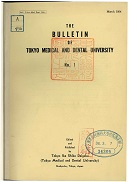All issues

Successor
Volume 28 (1981)
- Issue 4 Pages 111-
- Issue 3 Pages 77-
- Issue 2 Pages 27-
- Issue 1 Pages 1-
Volume 28, Issue 4
Displaying 1-3 of 3 articles from this issue
- |<
- <
- 1
- >
- >|
-
Akihisa UCHIDA, Takahiro HORIKAWA, Masaroh MATSUURA, Tsuguo WATANABE1981Volume 28Issue 4 Pages 111-116
Published: 1981
Released on J-STAGE: November 22, 2020
JOURNAL OPEN ACCESSThe effect of sonication on the viability of Mycoplasma salivarium and Mycoplasma orale was examined as a preliminary investigation on the quantitative studies on mycoplasmas in the dental plaques. Mycoplasma cell aggregations suspended in PBS or liquid medium were sonicated and the samples were removed at 5-second intervals for 20 seconds to check the viable counts. Inactivation of the mycoplasmas was almost directly proportional to the sonication time. M. orale was more sensitive to sonication than M. salivarium. Mycoplasmas were damaged more readily in PBS than in the liquid medium. Dental plaques suspended in PBS were also sonicated exactly as mentioned above. The number of mycoplasmas in the dental plaques (1 mg) ranged from l.09×102 to l.75×105 cfu. The desirable sonication time to prepare the homogeneous suspensions of dental plaques was concluded to be 5 seconds.View full abstractDownload PDF (1238K) -
Akihisa UCHIDA1981Volume 28Issue 4 Pages 117-123
Published: 1981
Released on J-STAGE: November 22, 2020
JOURNAL OPEN ACCESSThere has been only a fragmentary knowledge concerning mycoplasmas in the dental plaques and, in particular, no quantitative studies have been made on them. For this reason, isolation and enumeration of the mycoplasmas in the dental plaques have been attempted in this present study. The incidence of mycoplasmas was significantly higher in the dental plaques accumulated on the molars (76.l%, 35/46 specimens) than on the incisors (37.2%, 16/43); on the healthy enamel surface (hereafter called normal plaques; 6 l.0%, 61/100) than on the superficially decayed enamel surface (hereafter called caries plaques; 14.8%, 4/27) and on the healthy cervical enamel surface but in contact with the inflamed gingival marginal area (hereafter called gingivitis plaques; 30.3%, 10/33). The number of organisms (cfu) in the dental plaques (mg) was g1eater in the normal plaques (range, 0-1.57×106: mean, 6.31×104) than in the caries (0-4.62×102: 2.28×102) and in the gingivitis (0-4.14×104: 6.55×103). There was a significant difference only between the normal and caries plaques. In addition, the number of organisms in the 1-day and 3-day-old dental plaques suggested that the mycoplasmas were not one of the microorganism s which appeared at the early stages of dental plaque formation. M. salivarium (311 strains) and M. orale (13) were isolated from 67 samples of dental plaques, but U. urealyticum was not. Of the 67 samples, 60 (89.5%), 1(l.5%) and 6 (9.0%) samples were positive for M. salivarium, M. orale and both of these two species, respectively.View full abstractDownload PDF (1660K) -
Kenji SAKAHIRA, Yukio TSUNODA, Kuniko TAKEGAWA, Etsutaro IKEZONO1981Volume 28Issue 4 Pages 125-134
Published: 1981
Released on J-STAGE: November 22, 2020
JOURNAL OPEN ACCESSThe effects of isoproterenol, dopamine, dobutamine and the combination of dopamine and dobutamine were compared by using forty-two mongrel dogs in hemorrhagic shock states. The combined use of dopamine and dobutamine was considered to be the most effective in the treatment of hemorrhagic shock in view of the small increase in heart rate, the large and steady increase in cardiac output, the maintenance in renal arterial blood flow and the mild increase in peripheral resistance.View full abstractDownload PDF (2268K)
- |<
- <
- 1
- >
- >|